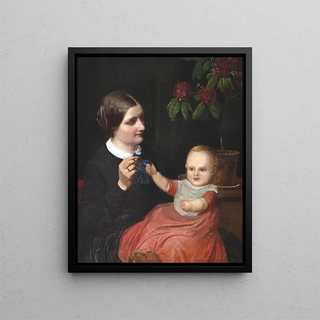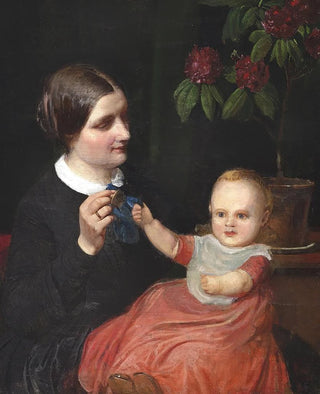Art print | Portrait of the artist's wife with her son Poul on her knees - Wilhelm Marstrand


View from behind

Frame (optional)
Portrait of the artist's wife with her son Poul on her knees - Wilhelm Marstrand – Captivating introduction
In the world of art, some works transcend the mere frame to become true testimonies of life and human emotions. The "Portrait of the artist's wife with her son Poul on her knees" by Wilhelm Marstrand is one of those pieces that captivates and fascinates. Created in the 19th century, this artwork immerses us in the intimacy of a family scene, where love and tenderness blend with the beauty of everyday life. By observing this painting, the viewer is invited to share a privileged moment, a bubble of sweetness frozen in time, where the mother and child seem to flourish under the artist's benevolent gaze.
Style and uniqueness of the work
Marstrand's style is distinguished by delicacy and meticulous attention to detail. In this piece, the woman's features, imbued with softness, reveal a sensitivity that goes beyond simple representation. The colors, carefully chosen, create a visual harmony that envelops the viewer. The play of light, subtly orchestrated, emphasizes the volumes and expressions, bringing this intimate scene to life. The posture of the child on his mother's knees suggests closeness and protection, while the woman's gaze, both serene and contemplative, hints at a depth of soul. Marstrand succeeds in capturing not only the physical appearance of his subjects but also the very essence of their emotions, making this work a true masterpiece of Romantic painting.
The artist and his influence
Wilhelm Marstrand, an emblematic figure of 19th-century Danish art, made his mark with his talent and unique approach to painting. Trained at the Royal Danish Academy of Fine Arts in Copenhagen, he quickly developed a style that combines realism with romantic sensitivity. His works, often inspired by daily life and human relationships, testify to a deep understanding of feelings and interactions. Marstrand was also influenced by his travels abroad, notably in Italy, where he observed the old masters and absorbed their techniques. His legacy continues to influence the art world today.

Matte finish

View from behind

Frame (optional)
Portrait of the artist's wife with her son Poul on her knees - Wilhelm Marstrand – Captivating introduction
In the world of art, some works transcend the mere frame to become true testimonies of life and human emotions. The "Portrait of the artist's wife with her son Poul on her knees" by Wilhelm Marstrand is one of those pieces that captivates and fascinates. Created in the 19th century, this artwork immerses us in the intimacy of a family scene, where love and tenderness blend with the beauty of everyday life. By observing this painting, the viewer is invited to share a privileged moment, a bubble of sweetness frozen in time, where the mother and child seem to flourish under the artist's benevolent gaze.
Style and uniqueness of the work
Marstrand's style is distinguished by delicacy and meticulous attention to detail. In this piece, the woman's features, imbued with softness, reveal a sensitivity that goes beyond simple representation. The colors, carefully chosen, create a visual harmony that envelops the viewer. The play of light, subtly orchestrated, emphasizes the volumes and expressions, bringing this intimate scene to life. The posture of the child on his mother's knees suggests closeness and protection, while the woman's gaze, both serene and contemplative, hints at a depth of soul. Marstrand succeeds in capturing not only the physical appearance of his subjects but also the very essence of their emotions, making this work a true masterpiece of Romantic painting.
The artist and his influence
Wilhelm Marstrand, an emblematic figure of 19th-century Danish art, made his mark with his talent and unique approach to painting. Trained at the Royal Danish Academy of Fine Arts in Copenhagen, he quickly developed a style that combines realism with romantic sensitivity. His works, often inspired by daily life and human relationships, testify to a deep understanding of feelings and interactions. Marstrand was also influenced by his travels abroad, notably in Italy, where he observed the old masters and absorbed their techniques. His legacy continues to influence the art world today.






